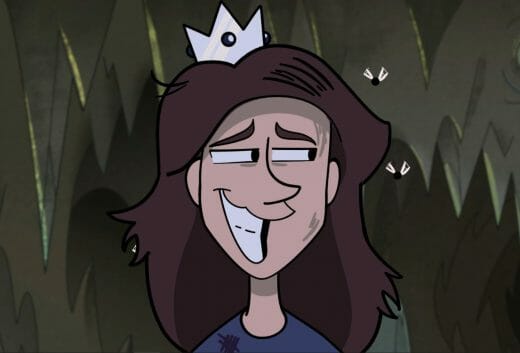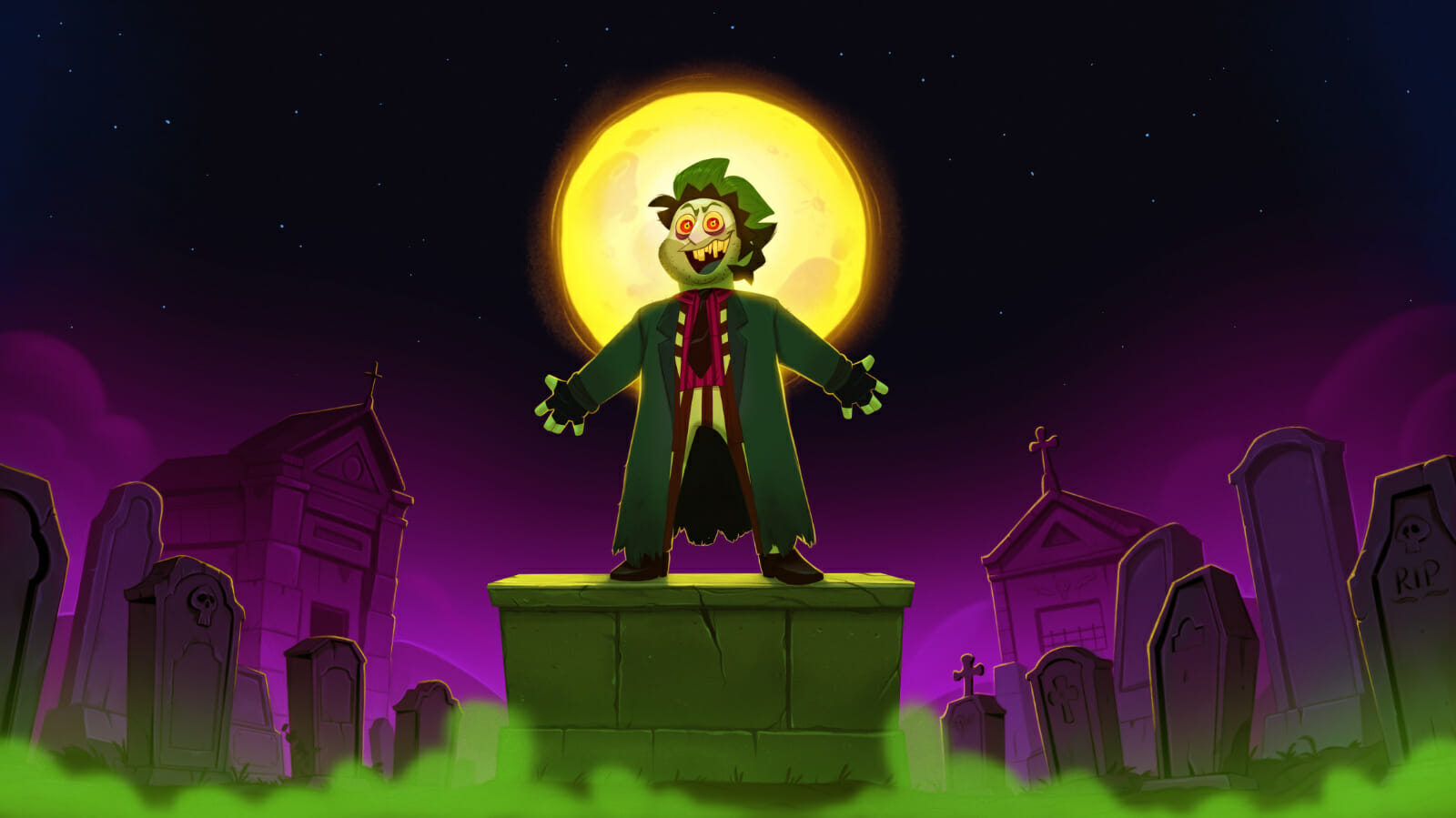
Nicole Rodriguez is a storyboard artist with experience on productions for Bento Box, Cartoon Network, Titmouse and SpindleHorse. In her spare time, Nicole takes on personal projects to sharpen her storyboarding skills, including two fan animatics of the Beetlejuice musical.
She posted the first animatic two years ago, drawing from “Invisible (Reprise)” and “Say My Name.” The songs find the lonely teenager Lydia Deetz on the roof of her new house, where she first encounters the eponymous demon, Beetlejuice.
Two months ago, Nicole posted a follow-up fan animatic set to “The Whole ‘Being Dead’ Thing.” Sung by Alex Brightman as Beetlejuice, it serves as a macabre (and funny!) introduction to the stage production. Beetlejuice is a larger-than-life character, which Nicole takes advantage of in her animatics by visually breaking the fourth wall while using surreal imagery fit for a true animated adaptation.
We sat down with Nicole Rodriguez to discuss working in the animation industry during the pandemic, the nature of fan art, and the courage required in creative pursuits.
What prompted you to make animatics for YouTube? And fan animatics for Beetlejuice: The Musical in particular?
I was still pretty new to boarding. I was a board revisionist on Steven Universe and then boarded on The Owl House for a little bit. When I was making the first animatic, I was trying to learn. I didn’t go to school for storyboarding, so I had to learn through my friends and through doing it. And I was a big fan of the Beetlejuice musical, because I had recently seen it on Broadway.
I didn’t feel confident enough to write something. And I love music and musicals, and boarding to music is really fun! I wanted to use that as a vessel to learn boarding. So it was a learning tool, and a way to prove to myself that I could do this, because boarding was very intimidating to me for a while.
For the second animatic, I just wanted to make something bigger and show that I learned a lot since I made the first one. I didn’t think it was going to become such a big undertaking. And then as I was doing it I was like, “Oh wait, this is going to take a really long time.” But I was down for it, and I’d never committed to finishing such a long-term project before.
What did the process of storyboarding these fan animatics look like?
I tend to thumbnail a bunch first. As fast as possible. I’ll jot down every shot idea that I have to figure out if shot flows work, and to figure out if I like how this is going. Sometimes I have to see it in action, especially if there’s a camera move or something. I need to test it out to see if it works the way that I want it to in my head.
Once all the thumbnails are laid out, I go in with roughs, and I would emphasize Beetlejuice’s acting because he was the main character. I really focused on that for a while, where I would rough all the acting. It was during the pandemic, so I would stream it on Twitch because I just felt so in my own little box. It was a bit of an outlet. I got to talk to people. Or they would talk in the chat. It was fun that way.
When it came to cleans, I made the decision, which is part of why it took so long, to colour everything in with grayscale and limited colour. Normally in boarding, you don’t do that. You shouldn’t do it because all it does is slow things down and make the process worse for everybody. But since I wasn’t sending this off to get animated, or turning it into anything else, I thought, “Let me make it look pretty.”
Somewhere along the way, this incredibly talented artist Jeannette Arroyo said, “Hey, I’d love to do backgrounds.” So she did a bunch of the backgrounds, and so did a friend of mine, Amber Blade Jones, at the final stretch. Having the backgrounds in there solidified it looking really nice, and I don’t think it would have been half as good if they hadn’t put their time and energy into that.
It was a pretty regular process over the course of two years. Off and on, because I also have my regular job. I didn’t always spend the time on it but I wanted to make sure it got done.
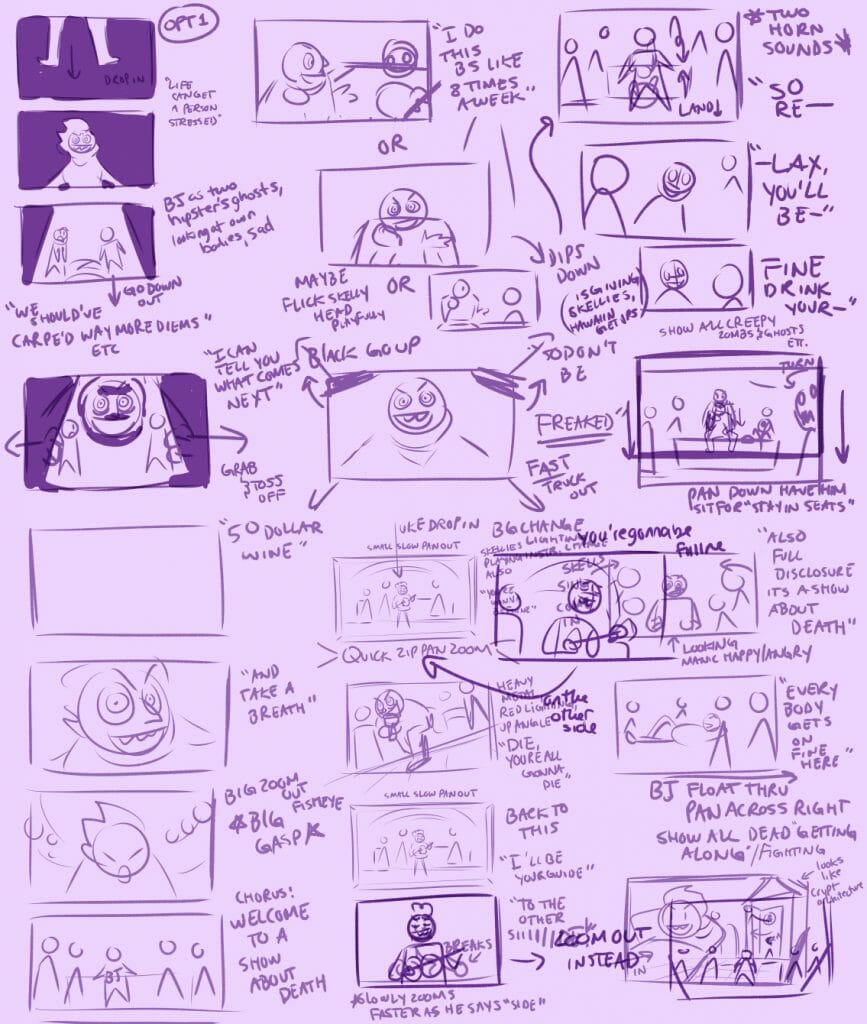
What techniques and programs did you use in these animatics?
It was just Storyboard Pro, which was great. For the backgrounds, they used a mix of Clip Studio and Photoshop. I learned a lot of things you could do in the program through my job on Central Park. People would give me files with stuff in it that I didn’t know how to do, so I reverse-engineered it. It turns out it wasn’t that hard.
The Beetlejuice characters have had many iterations across film, animation and the stage. What did the design process for your interpretation look like?
It was surprisingly quick. I’ve never worked professionally as a designer. But I’ve drawn my own things and I’ve had to design things before, in my free time. I wanted something that was a bit of a marriage between the stage play, which is my favourite version, and also bringing my own spin on it. Keeping in mind that it had to be something I could draw a million times.
When I made the first animatic, I didn’t make any designs. I drew the characters once, and then I was like, “Okay, I’m going to roll with it.” It made the whole thing a lot harder to do. I knew if I was going to make another one, I’d have to figure out solid designs for these and animate them a little simpler.
There was a lot of ganking off of the stage play, but then I brought in what would be fun to draw for animation. It only took me about a day. It doesn’t always happen, but I drew one or two different designs and I liked it. So it worked out.
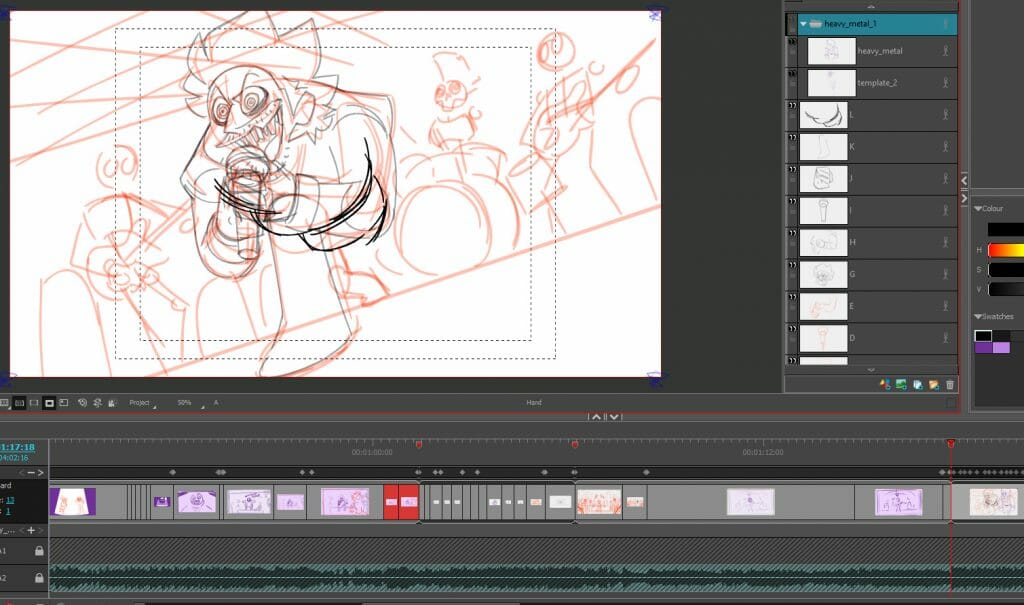
How did you choose the limited colour palette? In particular, when to use colour?
I was doing tests for how I wanted it to look cleaned up. When I did it just lined, with no values or fill in or anything, it felt like it needed a little something. So I tried putting a little bit of grey in here, putting a little in there. When I landed on grayscale and limited colour, it was to make certain things pop a little more.
Beetlejuice’s green hair is this iconic thing, so having that made sense. Then there’s one part where he’s on the ukulele and everything’s in colour for a little bit and it gives an effect that you wouldn’t get otherwise. It changes the tone.
Something they implemented in the stage play, that I thought was really fun, was that his hair is kind of like a mood ring. It reflects how he’s feeling. That was a big motivator. It also made him stand out, because he’s the main guy in the song.
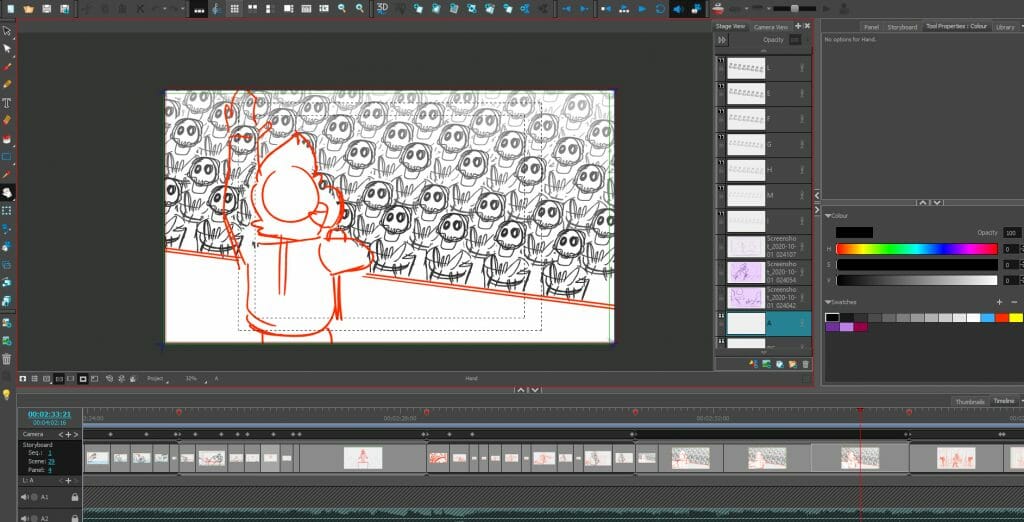
Which parts of these projects were the most interesting or challenging to animate?
I made the very smart decision to make all of the chorus and extras skeletons. That was very annoying because no matter how much you simplify skeletons, they’re really annoying to draw a bunch of times.
There’s one part in “The Whole Being Dead Thing” where a bunch of them are playing music in a band. And because I’m a crazy person I wanted it to be vaguely on beat with the music. They’re not playing the right notes or anything. But drums are possible. Getting someone to play drums convincingly — I made it work because it’s not the main focus. You can get away with it because it’s a skeleton in the background.
What were the challenges in adapting a stage musical into animation? How closely did you stick to the choreography of the musical?
Honestly, I used almost no stage choreography at all. The only thing that I kept in mind was that, for “The Whole Being Dead Thing” they have a coffin that’s center stage that they do stuff around. Keeping a coffin there as a stage reference for some of the shots is the only main thing I took. And not even in the same way.
It’s not super difficult to translate musical stuff to animation. They’re both so over-the-top and animation is already thought of like a stage. You have to stage things similarly. If anything, I feel like musicals lend themselves to animation. I always really want to see musical stuff be made into animation. You can do a lot of really fun stuff that you couldn’t otherwise do.
Especially with this musical. They went so over-the-top with all of the stage effects and all of the choreography. It’s like a cartoon, almost.
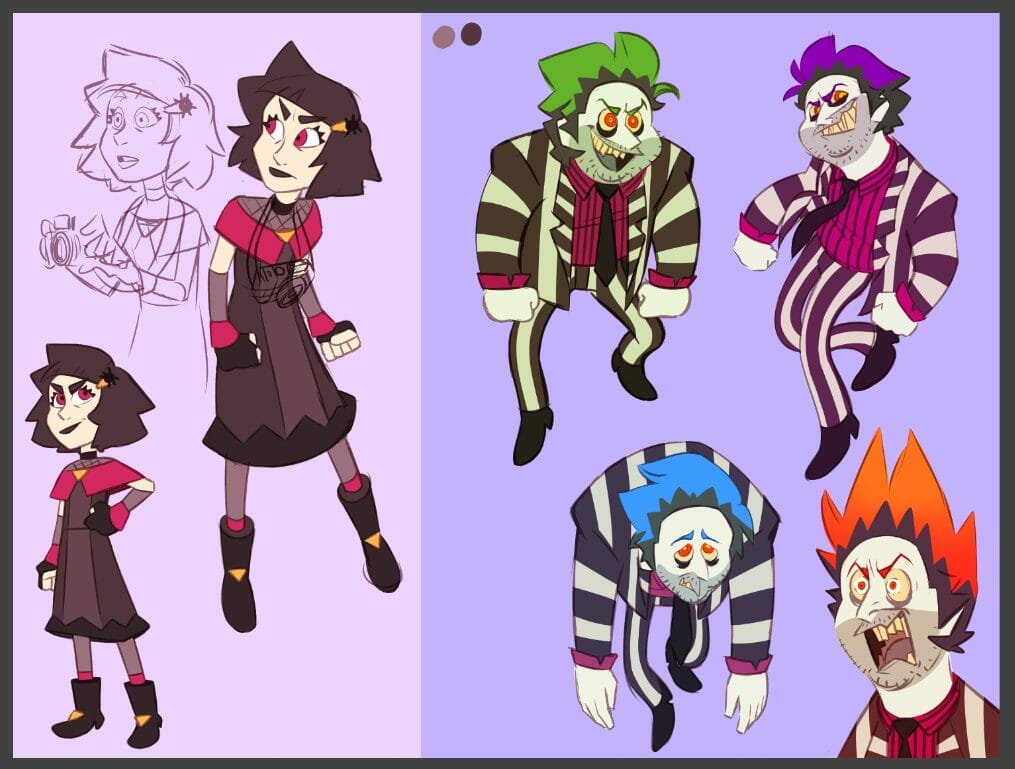
What personal projects are you currently working on, or hope to work on in the future?
I’m currently trying to get better at writing. Because, whether it’s just by myself in an indie capacity or taking it to studios, I want to pitch shows. I have a couple of different projects in mind that I’m trying to make. I always have a million little projects, but that’s the main thing: creating pitches so that I can maybe write a show.
I’m also learning how to do action boarding a little better. I’m not actively currently working on it, but I would like to get back to it. There’s this Dungeons & Dragons show called Dimension20 that’s great because they’re very descriptive. There’s a motorcycle car chase that I think would be perfect as a vessel to learn the kind of action boarding that I want to do.
Outside of animation, I’m doing a comic for Oni Press with Erin Cabelly and Eugene Levitzky at the moment.
What advice would you have for other animators (or aspiring animators) looking to put their personal projects out online?
Just do it! I waited so long. The only thing I regret is that I didn’t do all this stuff sooner. Boarding was so intimidating to me. Making my own things was so intimidating to me. It still is, but I’m trying to force myself a little bit, because there’s such a good feeling when you finish something.
Really, the only thing that’s going to make you do it is just doing it. Even if you think it sucks, because there’s a good chance that it doesn’t suck, and that other people are going to like it. And you’re going to learn! It’s the best way to learn.

- Interested in seeing more work from Nicole Rodriguez? You can follow her on Twitter and Instagram, and support her personal projects on Ko-Fi.
- Summoning the courage to storyboard your personal projects? Artists can download a free 21-day trail of Storyboard Pro.


